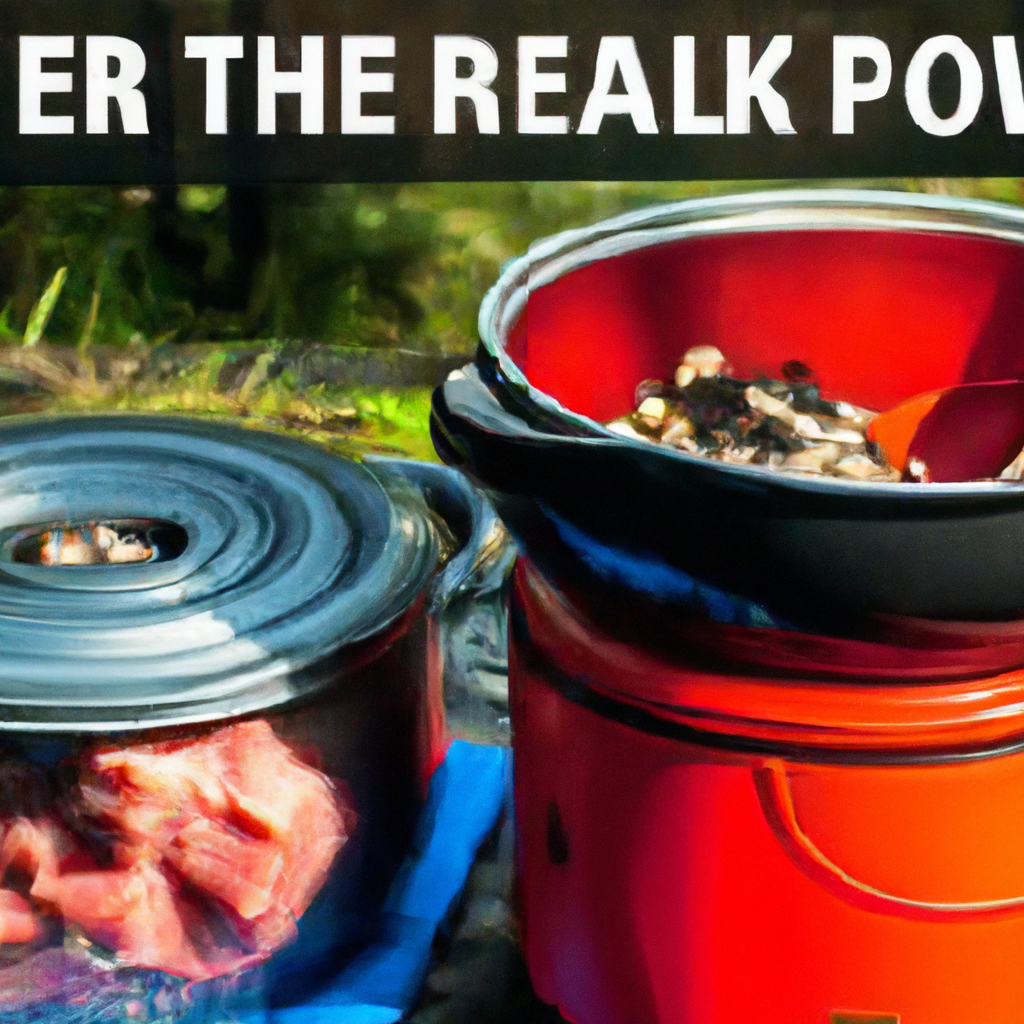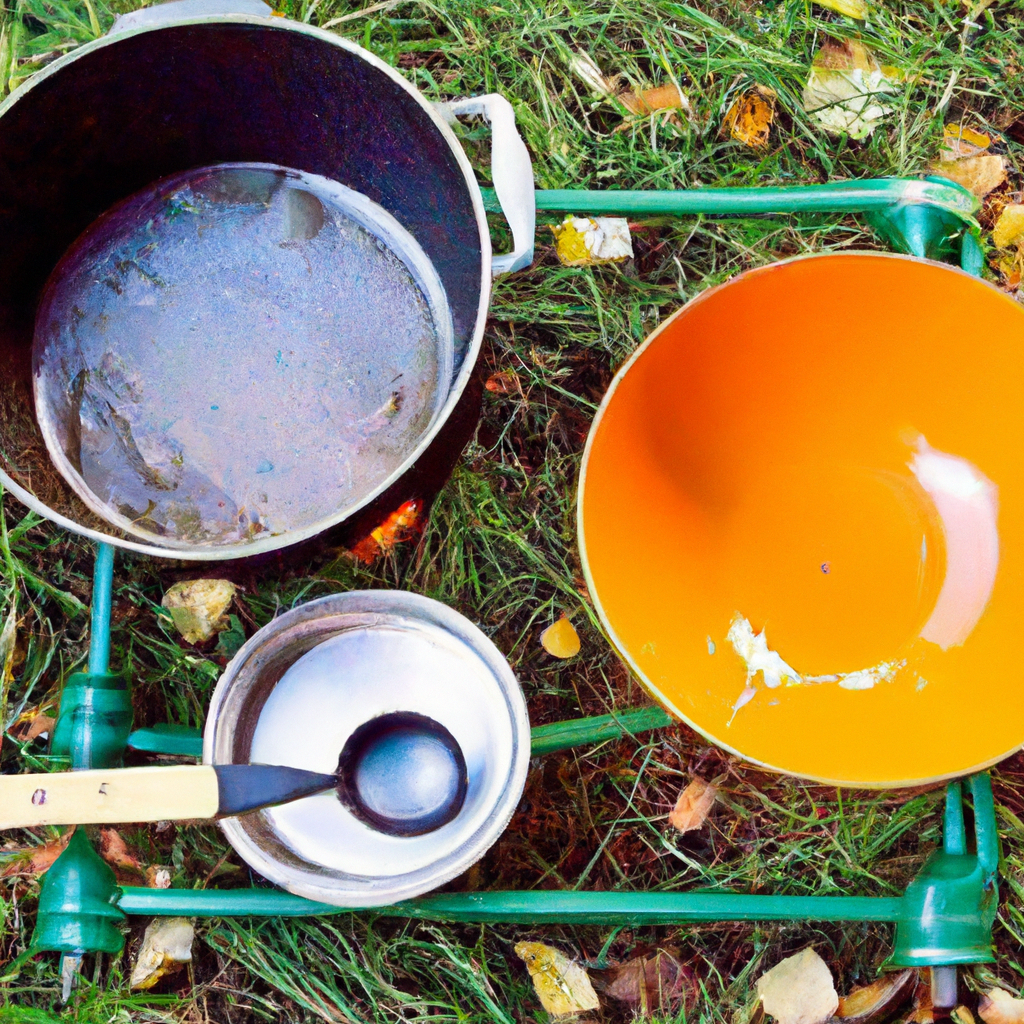Picture this: you’re out in the wilderness, surrounded by breathtaking landscapes and immersed in the tranquility of nature. But just as you’re settling into your camping adventure, you suddenly realize that you’ve run out of food and water. Panic sets in, but fear not, because in this article, we’ve got you covered. We’ll explore some practical solutions and resourceful tips to help you navigate through the challenges of running out of provisions while camping, ensuring that your outdoor experience remains enjoyable and safe. So, take a deep breath and let’s find out what you can do if you find yourself facing this predicament.

Preparing for a Camping Trip
Camping is a wonderful way to connect with nature and enjoy the great outdoors. However, it’s important to be prepared in case you run out of food or water during your trip. By following a few key steps, you can ensure that you have enough supplies to last throughout your camping adventure.
Making a food and water checklist
Before embarking on your camping trip, it’s essential to create a checklist of the food and water you’ll need. Start by estimating how many meals you’ll be having each day and the number of people in your group. This will give you a rough idea of how much food you should bring. Don’t forget to factor in snacks and beverages as well.
For water, it’s crucial to determine how much you’ll need for drinking, cooking, and cleaning. The general recommendation is to bring at least one gallon of water per person, per day. If you plan on engaging in strenuous activities, consider bringing even more.
Choosing food and water storage options
Once you have a clear idea of the food and water you’ll need, it’s important to consider the storage options. For keeping your food fresh and safe from animals, investing in airtight containers or coolers is a smart choice. These will help maintain the temperature of perishable items and prevent them from spoiling.
When it comes to water storage, durable water containers or water bladders are ideal. These containers are designed to be lightweight, portable, and resistant to leaks. Additionally, consider bringing hydration packs or water bottles for easy access to water during hikes or outdoor activities.
Bringing extra supplies
No matter how well you plan, there’s always a chance that your camping trip may last longer than anticipated or you may encounter unexpected situations. To account for these possibilities, it’s wise to bring extra supplies of food and water.
Pack non-perishable items such as granola bars, nuts, or dried fruits that have a long shelf life. These can come in handy if you run out of fresh food or find yourself in a situation where cooking is not possible. Additionally, consider bringing water purification tablets or a portable water filter as backup options for purifying water from natural sources. These extra supplies can provide crucial sustenance during an unforeseen emergency.
Conserving Food and Water
While it’s important to be prepared with enough food and water, it is equally essential to conserve these resources during your camping trip. By planning your meals, using alternative cooking methods, and finding natural sources of water, you can make your supplies last longer.
Planning meals and portion sizes
One of the most effective ways to conserve food is to plan your meals in advance. By portioning your meals correctly, you can avoid wasting food. Consider using resealable bags or containers to pack individual portions. This not only prevents overeating but also helps in managing the storage space efficiently.
It’s also helpful to choose foods that have a longer shelf life, such as dehydrated or freeze-dried meals. These lightweight options can be easily rehydrated with water and provide essential nutrients. Packing foods that are high in calories and protein can help keep you sustained for longer periods.
Using alternative cooking methods
While campfires are a traditional and enjoyable way to cook meals, they can also consume a significant amount of fuel and resources. To conserve these valuable supplies, consider using alternative cooking methods such as camp stoves or portable grills. These devices are designed to be fuel-efficient and can help you save on both food and water.
Finding natural sources of water
If your water supply begins to run low, it’s crucial to explore natural sources of water. Before drinking water from any natural source, it’s important to purify it properly, which will be discussed in more detail later. However, if you’re in dire need of hydration, there are a few ways to collect water from nature.
Look for streams, rivers, or lakes nearby and collect water using a clean container or a water collection system. If it has recently rained, take advantage of this opportunity and collect rainwater. Additionally, in desperate situations, digging for groundwater may be an option to consider. However, make sure to exercise caution and be mindful of any potential pollutants or contaminants that may be present.
Purifying Water Sources
Finding clean and safe water sources is essential for your survival during a camping trip. However, water obtained from natural sources may harbor harmful bacteria, viruses, or parasites. In order to protect yourself from waterborne illnesses, it’s crucial to purify the water you collect.
Understanding water purification methods
There are several effective methods for purifying water while camping. These include boiling, using water filters or purifiers, and utilizing chemical treatments. Each method has its own advantages and limitations, so it’s important to choose the one that suits your needs and available resources.
Using water filters or purifiers
Water filters and purifiers are excellent tools for removing impurities from water. They are specifically designed to eliminate bacteria, protozoa, and other contaminants. Portable water filters are lightweight, easy to use, and can be a reliable solution for purifying water from natural sources. Look for filters that meet the required standards and have positive reviews from outdoor enthusiasts.
Boiling water
Boiling water is one of the most effective and reliable methods of water purification. By bringing water to a rolling boil for at least one minute (or three minutes at higher altitudes), you can kill most types of pathogens. This method is straightforward, requires minimal equipment, and can be done with a camp stove or even an open fire.

Finding Emergency Food Sources
If you find yourself running out of food while camping, it’s important to know how to identify and procure alternative food sources. While it’s crucial to have basic knowledge and skills in this area, it’s advisable to avoid foraging for food unless you are confident in your identification abilities and have the necessary expertise.
Identifying edible plants and fungi
If you have prior knowledge and experience in botany, you may be able to identify edible plants and fungi in the wilderness. However, it’s important to exercise extreme caution when foraging for food. Misidentification can lead to severe illness or even death. Only consume plants or fungi that you are absolutely certain are safe to eat, and always consult a reputable field guide or expert.
Fishing or hunting for food
Another option for procuring food in an emergency situation is fishing or hunting. If you have the necessary equipment, skills, and legal permission, fishing or hunting can provide a valuable source of sustenance. However, it’s important to familiarize yourself with local fishing and hunting regulations, obtain the required permits, and follow ethical practices.
Foraging for insects or small animals
While it may seem unconventional, insects and small animals can be a viable food source in emergency situations. In many cultures, insects are considered a delicacy and are a rich source of protein. However, it’s important to be cautious and avoid eating insects or small animals that may be toxic or carry diseases. Only consume those that are known to be safe and have been properly cooked or prepared.
Contacting Park Authorities or Nearby Help
In a camping emergency situation, it’s crucial to reach out for assistance as soon as possible. Whether it’s notifying park authorities, campground staff, fellow campers, or emergency services, seeking help can make a significant difference in resolving the situation effectively.
Notifying park authorities or campground staff
If you find yourself in a campsite or at a national park, the first course of action in an emergency situation should be to notify park authorities or campground staff. They are trained to handle various types of emergencies and will have the necessary resources to assist you promptly. Provide them with clear and concise information about your location, the nature of the emergency, and the assistance required.
Asking fellow campers for assistance
In some cases, fellow campers may be able to provide immediate help or guidance in emergency situations. If you are camping near other people, don’t hesitate to approach them and explain your predicament. Most campers are friendly and willing to lend a hand. However, it’s important to remember that not everyone may be equipped or trained to handle certain emergencies, so use your judgment when seeking assistance.
Utilizing emergency services
If your camping trip takes you to a remote area where park authorities or campground staff are not available, your best option is to contact emergency services. Call emergency services using your mobile phone or emergency satellite communication devices if you have them on hand. Provide them with precise details about your location, the nature of the emergency, and the assistance required. Stay calm and follow any instructions provided by the emergency services.
Creating Emergency Signals
In some situations, it may be necessary to create emergency signals to attract attention and facilitate your rescue. When in distress, every effort should be made to alert potential rescuers to your location.
Building a signal fire
A signal fire is one of the most effective means of attracting attention from a distance. To create a signal fire, gather dry wood and kindling to ensure a bright flame. Choose an area that is visible from a distance and free from any obstructions. Once the fire is lit, use green vegetation or materials that create dense smoke to further enhance its visibility. Remember to practice fire safety and ensure that the fire does not spread.
Creating SOS signals
The international distress signal SOS can be easily created to call for help. To create the SOS signal, arrange rocks or other materials on the ground or beach to form large, visible letters. The SOS signal consists of three short signals, followed by three long signals, and then three short signals again. This pattern is recognized universally as a distress signal and is easily understood by potential rescuers.
Using mirrors or reflective objects
If you have access to a mirror, a compact disc, or any other reflective object, you can use it to create signals that can be seen from a distance. Aim the reflection toward the direction of potential rescuers or passing aircraft. Reflecting sunlight can produce bright flashes that catch attention and indicate your location. Keep the signal as steady as possible to increase visibility and avoid confusion.
Seeking Natural Water Sources
In situations where your water supply has run out, it’s important to search for natural sources of water. Understanding how to find and utilize these sources can be crucial for your survival.
Searching for streams, rivers, or lakes
Streams, rivers, and lakes are excellent sources of fresh water in the wilderness. If you find yourself in need of water, search for these natural water sources by following the sound of running water or examining topographical maps if available. Be cautious when collecting water from these sources and ensure that it is properly purified before consumption.
Collecting rainwater
Collecting rainwater is a valuable technique for obtaining water in emergency situations. By placing a clean container or tarp under a well-positioned and secure surface, you can collect rainwater. Ensure that the surface is free from contaminants and debris that may affect the quality of the water. Remember to purify the rainwater before drinking or using it for cooking.
Digging for groundwater
In some cases, it may be necessary to dig for groundwater. Look for areas where the soil appears damp or where vegetation indicates the presence of water. Dig a hole several feet deep and wait for it to fill with water. Alternatively, create a solar still by digging a hole, placing a container in the center, covering the hole with a plastic sheet, and securing the edges to trap moisture. Condensation will collect on the plastic, providing a source of water. Again, ensure that any water obtained is properly purified before consumption.
Using Survival Techniques
When faced with a situation where you have run out of food or water, it’s essential to resort to survival techniques that can help sustain your well-being.
Building primitive fishing tools
If you have access to a body of water, building primitive fishing tools can be an effective way to procure food. Utilize natural materials such as branches, vines, or cordage to create fishing lines and hooks. Bait the hooks with insects, live bait, or small pieces of food and cast them into the water. Patience and persistence are key when using this method, as fishing can often be unpredictable.
Setting up a trap for small animals
Another survival technique to consider is setting up traps for small animals. Research and learn how to construct basic snares or traps using natural materials. Position them in areas where animals are likely to pass, such as game trails or near sources of water. Exercise caution and respect local hunting regulations to ensure ethical practices when using this method.
Catching and purifying rainwater
As mentioned earlier, collecting rainwater is an excellent way to obtain clean water. If you are in an area with frequent rainfall, consider using a rain catchment system to collect and store rainwater for future use. Purify the collected rainwater using appropriate methods before consumption.
Navigating to Civilized Areas
In dire situations where you have completely run out of food and water, navigating your way to civilized areas becomes essential for survival. With some basic knowledge and navigational tools, you can increase your chances of reaching help.
Using a compass or navigational tools
Having a compass or other navigational tools is crucial for finding your way to civilized areas. Familiarize yourself with the basics of using a compass and learn how to determine direction based on landmarks or the sun’s position. By using these tools, you can navigate through unfamiliar territory and increase your chances of finding help.
Following natural landmarks
Nature is filled with natural landmarks that can aid in navigation. Mountains, rivers, valleys, and distinctive rock formations can serve as valuable reference points. Before embarking on your camping trip, study maps and educate yourself about the region’s topography. This knowledge can be instrumental in recognizing important landmarks and directing you towards safety.
Creating makeshift navigation aids
If you find yourself without navigational tools or are in a situation where they are not readily available, it’s important to get creative and make makeshift navigation aids. Use materials found in your environment to create landmarks or markers that you can use as reference points. For example, stacking rocks to create a cairn can help you remember a significant turn or junction on your path. Be resourceful and use your surroundings to your advantage.
Emergency Food and Water Storage Methods
Finally, when preparing for a camping trip, it’s always wise to pack emergency food and water storage methods. These can serve as backups in case of unforeseen circumstances or to extend your supplies during emergencies.
Packing compact emergency rations
Compact emergency rations, such as energy bars, meal replacement bars, or dehydrated meals, are excellent options for backup food supplies. These items are lightweight, easy to carry, and have a long shelf life. Pack enough emergency rations to sustain you for a few extra days or longer if possible. Remember to rotate these supplies periodically to ensure their freshness.
Bringing water purification tablets
Water purification tablets are compact and easily portable, making them an ideal solution when you run out of clean water. These tablets are specifically designed to kill bacteria, viruses, and other harmful microorganisms. Follow the instructions provided with the tablets and ensure that you have enough to purify the required amount of water for your needs.
Considering portable water filter options
Portable water filters are another effective method for purifying water during emergencies. Look for lightweight, portable options that are easy to use and can handle large volumes of water. These filters are designed to remove bacteria, protozoa, and other contaminants. Consider investing in a portable water filter that meets your specific needs and ensure that it is in proper working condition before embarking on your camping trip.
By being prepared, knowledgeable, and resourceful, you can increase your chances of surviving and staying safe in situations where you run out of food or water while camping. Remember, prevention is always the best approach, so plan accordingly, pack ample supplies, and know your limits. With proper preparation and a positive mindset, you can truly enjoy the wonders of the great outdoors while ensuring your own well-being. Happy camping!

